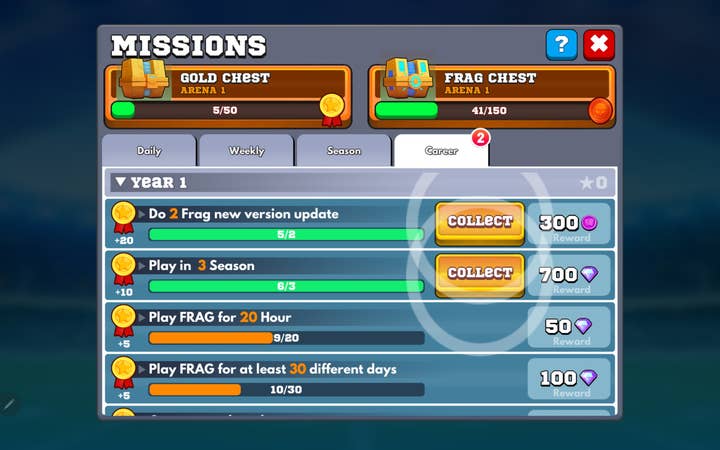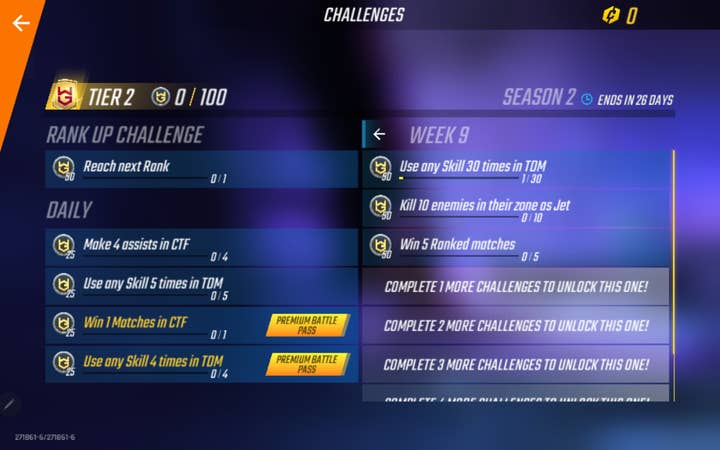Push and pull: How to build an in-game economy
Unity Technologies' Julie Shumaker explains how to knit together the key components of a robust and engaging game economy
The economy of your game extends far beyond the contents of the in-game store. A well constructed economy is balanced, nuanced, and embedded in the core gameplay loop, without being prohibitive to non-spenders.
In free-to-play (F2P) games and games-as-a-service (GaaS), the in-game economy is both a revenue driver and the key to crafting an engaging player experience. Achieving the right balance with its essential components will boost key performance indicators (KPIs) across the board, providing value to both you and your players.
Below, I've shared five tactics to help game developers construct and operate in-game economies that keep players engaged, inspired, and participating for the long term.
1) Implement both soft and premium currencies

Making use of virtual currencies enables players to remain immersed in the game setting without concerning them with the "real-world" value of items and activities. There are two types of virtual currencies:
- 1. Soft currency
Soft currency is earned primarily via gameplay and is often represented by a monetary symbol appropriate to the game narrative, such as coins or gold.
However you choose to visualize it, your soft currency should be available to spend on a wide range of items, activities, consumables, and upgrades -- in essence, the majority of items available for purchase. It might take players a huge amount of effort to amass enough of this "grind" currency for certain purchases, but they should not be mechanically prevented from doing so.
- Premium currency
Premium currency is primarily available for purchase with real-world money.

Your premium currency should be represented by something that is obviously more valuable than your choice of soft currency. Use items that are significant to the setting and are coveted within the gameworld -- dragon eggs, fuel cells, or enchanted stones, for example.
Limit the use of premium currency to exclusive items and cosmetics that do not afford competitive advantage. This is especially important in games with player-versus-player (PvP) mechanics. Games perceived as "pay-to-win" often suffer backlash and can alienate non-spenders, who make up the majority of players in any free-to-play game.
Soft currency does not usually generate revenue for you directly. Alongside premium currency, though, it is essential to the economy. Soft currency gets players used to the idea of spending, keeps them engaged and motivated, and emphasizes the relative value of premium currency.
2) Provide a variety of ways to earn and spend
To help you generate revenue, your game economy should consist of multiple "sources" and "sinks." In other words, there should be several ways for players to earn (source) and spend (sink) throughout the game. This flexibility encourages different player types to engage with the economy.
There should be several ways for players to earn (source) and spend (sink) throughout the game
- Sources
Use the earning of soft currency as the short-term goal of almost all player activity. Things like mission completions, special tasks, daily challenges, streak mechanics, rewarded ads, progression milestones, and lucky spins should have soft currency attached.
In contrast, there should only be two sources of premium currency. First and foremost, it should be promoted in exchange for real-word currency. Second, consider occasionally giving players premium currency as a gift or reward. This will have a positive impact on engagement, retention and monetization overall.

- Sinks
From a player perspective, purchasable items are the focal point of the economy. Some players are happy to grind and amass soft currency, while others spend money freely, but only if the game offers exciting things to buy. Without a variety of sinks to incentivize the player to continue sourcing, an economy falls apart.
Purchasables vary greatly depending on game genre and mechanics, but they fall into the following broad categories:
Customization is not only something that players will be excited to spend money on, it's also a retention booster
- Gameplay items and modifiers
Things like basic weapons, vehicles, potions, and upgrades should make up the cheapest items available in the stores, but big-ticket purchases also have their place. Modifiers such as boosters, points multipliers, and extra lives should follow the same rules.
As these items often affect gameplay, they are best made available for purchase with soft currency. They should fit seamlessly into the game world, and you should surface them often.
- Aesthetic/cosmetic items
As proven by many of the most popular F2P titles on the market, cosmetic and status items are a huge monetization opportunity. Customization is not only something that players will be excited to spend money on, it's also a retention booster.
Frustrated players are much more likely to abandon a fixed template than a unique character that they have invested time and money into crafting.
You should never paywall content that is central to the narrative
Aesthetic items give prestige but no competitive or power advantage, so they should be available for purchase with both soft and premium currency.
- Exclusives
Players should be exposed to exclusive purchase options such as status items, special events, and VIP passes that are only available in exchange for premium currency. While the majority of players will never make a purchase, there will always be a subset of non-spenders that can be persuaded to convert. Offering exciting and exclusive bonus content is a great way to do this.
You should never paywall content that is central to the narrative or force a player to spend. Instead, use special bonus content to encourage that first purchase.

3) Keep things aspirational
You should aim to manage the game economy so that most players always have more to work towards, but do not space out these moments so much that the next big item seems hopelessly out of reach. Make it easy for players to understand what they need to do to reach aspirations.
Experience points (XP) can be used to track and incentivize player progression. Do not allow players to exchange XP for anything in the store, but offer them aspirational milestones instead, so they can use XP to unlock access to tiers, items, and opportunities. It shouldn't be possible to directly "buy" progression, but it's not uncommon to see XP "boosters" in games (such as potions that accelerate XP gain, for example) to help speed progression along for more impatient players.
If your players reach an endgame, they will have no reason to keep engaging. You should always hint at more content to come, so that even players who have exhausted everything available will be likely to return. Even if all you can offer are variations of previous items, missions, or rewards, always leave something to work for. It's about the journey!
4) Guide players through peaks and valleys
Although your game hosts a broad range of player types and behaviors, an all-round effective economy takes all of your players on a similar journey. The numbers and currencies involved will differ, but the cadence and direction of their economic behavior typically trend in the same way.
If players find themselves consistently unable or unwilling to use currency, they will quickly lose motivation to earn it. The chart below exemplifies a good source vs sink correlation for soft currency.

Each player's currency reserves should fluctuate as they alternate between saving for, and actioning, big spend moments. These purchase spikes should hinge on points of achievement and progression as players both celebrate and get ready for bigger challenges ahead.
- Cadence
Big spend moments should occur roughly weekly, though this timescale varies depending on each player's level of activity. It's also important to keep things fresh by varying the pricing structure and cadence to make things a little less predictable for players.
It's important to keep things fresh by varying the pricing structure and cadence
- Player types
All player types are important. Hardcore players are your main source of both income and evangelism, but it's also important to keep casual players around. Casual players keep the community fresh, fill PvP slots, and generate income through ads and in other ways.
As a basic test of the economy, model out the journey of different player types to see how they fare. The three basic player types are:
- Ultra-engaged: 10 hours per day
- Loyal: Multiple sessions per day, averaging 1-2 hours
- Casual: 2-3 sessions per week
Loyal players are your primary target and priority test subject. However, if you can get players at either extreme of the engagement spectrum to follow a similar pattern of consistent saving and spending, you know that your economy has been well constructed.

5) Expose non-spenders to premium benefits
Outliers aside, with some encouragement and the right messaging, a great deal of non-spenders are open to conversion.
By occasionally giving non-spending players a taste of premium possibilities with small gifts of currency, you can tempt them to start actively buying. This light flow of premium currency encourages players to investigate and interact with opportunities that would otherwise be locked off.
- Incentives
Drip-feeding currency and advertising what's available for purchase has two positive impacts:
- Some players spend real money to gain the necessary premium immediately, thereby generating revenue.
- Other players grind hard in the hope of more premium rewards, thereby improving retention and engagement.
- Fairness and positivity
Drip-feeding premium currency notionally means all content can technically be gained by all players
A further benefit of drip-feeding premium currency is that it notionally means all content can technically be gained by all players, minimizing complaints that access to some content is exclusive.
Finally, occasional gifts and rewards prove to your players that your monetization structure is not exploitative. By topping up residual balances and helping players towards goals, you can only improve their disposition towards further spend.
- Opportunities
There is no single correct formula for how and when you distribute your premium currency gifts, but here are some good options:
- Appointment mechanics
Encouraging players to log in habitually, for regular sessions that are moderate in length, is beneficial for all involved. Consider putting a little bit of premium currency on the line in exchange for consecutive days logged in or attending specific calendar events.

- Achievements
Most games boil down to a series of tasks and challenges, so highlighting important ones with special rewards can be effective. Think about putting some currency up for tutorial completion -- this will improve the first-time user experience (FTUE) and get players accustomed to interacting with the economy early on.
- Progression
Rubber-stamping big milestones is a great incentivizer, just be careful not to give away premium currency for every little thing. Try marking every tenth level-up or new world unlocked, for example.
- Competition
Much of the value that players derive from premium currency is tied up in prestige and status. Competitive events such as PvP tournaments already attract a certain kind of player, so why not sweeten the deal with the prize?
The player always comes first
Your in-game economy should be designed to deliver an engaging and enjoyable player experience. Monetization will follow, but a truly finessed economy serves as a booster for retention and engagement -- and social metrics too.
When building your economy, you should do so with the player in mind: who they are, what they need, and what they want. At the end of the day, they all want essentially the same thing. Players want to derive value and enjoyment from a system that works as hard for them as they do for the economy. Give it to them.
As vice president of revenue, Julie Shumaker is responsible for global revenue-related activities derived from Unity's Operate Solutions: offerings that enable developers' success by providing products and insights to build profitable businesses. Shumaker's team has recently published the free ebook "How to build an in-game economy", which provides additional insights for creators looking to keep players engaged.
